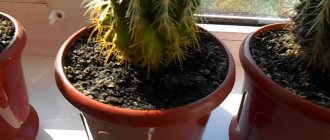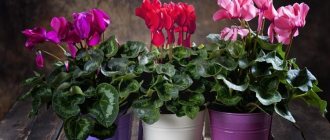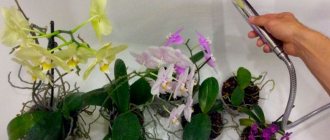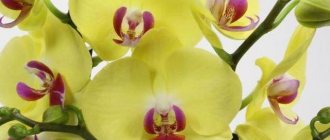The dendrobium orchid is a member of the Orchidaceae family. There are more than 1000 species of orchids in the plant world. This inflorescence is aerial, as it grows not only on the ground, but also in the mountains. And you can find this plant in China, the Himalayas and Vietnam.
- Transfer
The height of the orchid itself can reach from 0.4 m to 0.9 m. The trunk of this plant consists of tuberidia, which have a cylindrical shape. It also contains alternate leaves, lanceolate in shape and about 10 cm long. Peduncles grow from the recesses of the leaves, which can have about four flowers.
When an orchid blooms, its flowers can be of different colors: lilac, white, yellow, etc.
Botanical description
The unsurpassed beauty of Dendrobium nobile
nobile leads an epiphytic lifestyle and grows at an altitude of 1800 m above sea level in the Indian state of Sikiim.
Dendrobium is a sympodial orchid. This means that after the mother plant dies, daughter shoots appear in its place. They are the ones who continue the life of the plant.
The roots are hard and white. At the base of the straight stem there are cylindrical pseudobulbs. The alternate arrangement of lanceolate or linear leaves is characteristic.
Flower buds are located in the axils of the leaves. The life of each shoot is short - only 2-3 years. Then death occurs.
Fragrant snow-white, lilac, orange, red, yellow flowers densely cover long shoots. Thanks to breeding work, hybrid varieties with three-color colors have been developed.
Dendrobium noble is a bestseller. Before it goes on the store shelf, it is grown using stimulants. Therefore, after purchase, it can also bloom beautifully several more times. Then you will have to organize proper care for it in order to enjoy its flowering.
Planting/growing
A plant purchased in a store does not need to be replanted for at least 2-3 years.
With proper care and feeding, both the pot and the substrate in which it is located will last for several years. Dendrobium prefers a cramped container, so it is better not to rush with replanting, as in principle with any orchid; the less we disturb it, the stronger and healthier the plant. If you still decide to replant the plant ahead of schedule, you can use pine bark as a substrate. The flower endures this process extremely painfully, so it is carried out as rarely as possible. Phalaenopsis dendrobium is transplanted into a small plastic, ceramic or clay pot. It is desirable that the color of the pot be light. For good air circulation, light access and to prevent root rotting, it is recommended to make small holes throughout the container. A drainage layer must be placed at the bottom of the pot. Crushed brick, crushed stone, and foam are perfect for this.
Dendrobium orchid species
Dendrobium - the most beautiful flower
Among the variety of species and varieties of orchids, it is impossible to single out any special variety that would gain universal popularity. They are all beautiful in their own way.
Dendrobium nobile
Photo: Dendrobium nobile
Dendrobium nobile is native to Vietnam and the Himalayas. Shiny thick pseudobulbs are characterized by rapid growth and reach 0.5 m in length already in the first year of life. In the next season, flower stalks are formed, of which there are from 1 to 3 on one plant. The flowers are large, rich in color, up to 10 cm in diameter.
The natural-looking flowers are pure white, the tips of the petals are tinged with purple, the lip is cream, and the throat is dark purple in color. Hybrids have different colors and bloom several times a year.
Dendrobium phalaenopsis
Dendrobium phalaenopsis
Dendrobium phalaenopsis The orchid got its name due to the identical shape of flowers with phalaenopsis. Naturally distributed in Australia.
Pseudobulbs, together with leathery glossy leaves, reach 0.7 m in length. The species simultaneously forms up to 10 flowers, 8 cm in diameter, which are located on a high peduncle. More often the petals are painted burgundy.
Flowering is long-lasting, up to 2 months. It falls at the end of November - beginning of December. Several peduncles may appear on the same pseudobulb in one season. The best type for novice gardeners.
Dendrobium moniliforme
Dendrobium moniliforme
Dendrobium moniliforme Moniliforme is a noble dendrobium in miniature. The stem of the bush reaches no more than 15 cm in height, the rosette is very beautiful. Inexperienced gardeners should have this species at home, as it is easy to care for, especially since it blooms with beautiful “butterflies”.
Dendrobium parishii
Dendrobium parishii
Dendrobium parishii The hanging shoots of an epiphthous plant reach 0.3 m in length. There are also more powerful specimens.
The pointed oblong-lanceolate leaves grow up to 12 cm in length. Single flowers, painted in an amethyst-purple tone, bloom on the dendrobium. The rounded lip is densely strewn with purple-brown spots, the anther is purple, the column is snow-white. Characterized by summer flowering.
King's Dendrobium (Dendrobium kingianum)
Dendrobium kingianum
King's Dendrobium (Dendrobium kingianum) Native to Australia. The lower part of the cylindrical stems has a noticeable thickening, and at the top of the stem there are wide leaves.
Flowering is abundant, buds are formed in large quantities, in February. At this time, the King's dendrobium produces a long peduncle, on which 5 pink flowers bloom, exuding a pleasant aroma.
Dendrobium densiflorum
Dendrobium densiflorum
Dendrobium densiflorum is found naturally in the Himalayas. Unusual coloring. All flowers have a rich orange color, which even slightly hurts the eye. Flowering is very abundant. Up to 50 flowers can bloom simultaneously on racemose inflorescences 0.3 m long.
You can learn more about representatives of the orchid family from the video below.
Dendrobium: planting and care
Dendrobium orchid
By providing the plant with proper care, it will delight you with its flowering several times a year.
Features of cultivation: caring for a dendrobium orchid after purchase
White orchid flowers
After purchase, home orchids delight the owner with luxurious flowers for a long time, and it seems to the gardener that this will always be the case. But! Not so!
The fact is that cultivation for industrial purposes is carried out using growth and flowering stimulants. Long-acting fertilizers provide the flower with useful substances necessary for normal development for only a couple of months. Therefore, after bringing the dendrobium home, the maximum number of times it can still bloom on its own is once.
To enjoy frequent and long-lasting flowering, it is necessary to adhere to agrotechnical cultivation and care practices.
Content temperature
Variety of varieties
Active growth of the orchid is observed in conditions of moderate temperature. During the growing season, you will have to maintain the temperature at +20-25°C. It is important that the night temperature differs from the day temperature. At night +15-18°C is enough.
Therefore, the best choice would be a balcony or veranda. Daytime and nighttime temperature differences provide the plant with the formation of flower buds, which will contribute to lush flowering in winter. The plant will also grow better.
In autumn, growth slows down, so it is important to follow the life cycle of the plant, it is advisable to reduce the temperature regime. During the day you need to maintain +12-15°C, at night – +10°C is enough. This is a must .
In addition to lowering the temperature, for further flowering it is necessary to place the pot with the dendrobium orchid on the brightest windowsill or organize artificial lighting.
Too high a temperature will cause the roots to stop drinking water . Consequently, the leaves will dry out.
Lighting
Tropical beauty prefers bright but diffused light
A window sill on the south side is not the most suitable place for dendrobium, since the plant is harmed by temperatures above +27°C. The south side is suitable for keeping orchids only in late autumn and winter. If there is a lack of natural light, the pot with the plant must be illuminated with fluorescent lamps 4 hours a day.
The color of the leaves signals whether there is sufficient or insufficient natural light.
Green foliage is the norm. A light green color indicates that the plant has a lot of light, while a dark green color indicates a lack of light. If there is absolutely not enough light, the leaves become deep yellow.
Watering rules and maintaining humidity
Diffused lighting and moderate watering are the main conditions for successful growth.
During the period of active growth, the plant needs 2 waterings. In autumn, once a week is enough, and in winter – once a month. Watering an orchid at rest should be done carefully so as not to destroy the plant. It is best to water using the immersion method, that is, the pot with the mother plant is immersed in another container with warm water poured into it.
When watering, it is important to ensure that water does not fall on young pseudobulbs, otherwise they will rot.
When keeping it in an apartment, you should remember that dendrobium comes from a hot tropical climate with high humidity , so at home you should organize approximately the same conditions for it.
To soften dry air and increase air humidity, it is recommended to mist the foliage daily. It is necessary to ventilate the room. The pot with the plant can be placed on a tray with wet pebbles or expanded clay, or sphagnum moss can be placed.
Lack of moisture also affects the quality of the leaf blades - they grow twisted and wrinkled.
Transfer rules
Dendrobium transplant
An orchid is replanted once every 3 years. A signal that a transplant is necessary are roots protruding from the drainage holes.
In addition, it is necessary to replant if the soil has oxidized or the light-loving plants have become ill.
You need to replant carefully, into a special substrate. The soil contains bark, moss and foam balls.
Dendrobium roots are fragile and brittle, so it is important to be careful when replanting.
Transplanted into special pots for orchids. A drainage layer of large pieces of pine bark is poured onto the bottom of the container, then moss is placed, then the plant is replanted and covered with a new substrate. Watering is needed no earlier than a week after transplantation.
Fertilizer application
Dendrobium in a pot
Fertilizing is applied during the period of vegetative growth, starting in April and ending in September. You can feed once a week or 2 times a month. The concentration of applied fertilizers depends on the frequency of fertilizing. The more often feeding is carried out, the weaker it should be.
Reproduction at home
New plants are easy to obtain using division or cutting methods. In the first case, an adult bush that has completed flowering is taken.
Proceed like this:
- Remove the orchid from the pot.
- Clean it from the substrate.
- Divide into two or more pieces with a knife.
- Treat the cuts with charcoal powder.
Caution: you need to handle the roots very carefully - they are quite brittle.
Cuttings are suitable exclusively for deciduous dendrobiums. As material, take fragments of stems up to 100 mm long. They must be separated from the mother plant. Be sure to rub the cuts with charcoal.
Stick the cuttings into damp moss and hide them in a plastic bag. Do not water for the first 15 days. Monitor the temperature, the optimum is + 23 °C. Light is necessary, on the one hand, bright, and on the other, diffused.
When roots form, transplant the cuttings into regular orchid substrate. Flowers from young plants should be expected no earlier than 2 or even 3 years later.
Features of flowering
Flowering takes place in the last months of winter and spring. To admire the blooms, proper care is necessary at this time.
How to care during flowering?
Photo of an orchid: gorgeous bloom captivates the eye
In order for an adult plant to feel comfortable and produce a peduncle, it is necessary to ensure the correct development cycle, which should include a phase of active growth and rest. If these conditions are neglected, instead of a peduncle, the orchid will delight the owner with young shoots - children that will develop from the pseudobulb.
Thanks to breeding work, you can see different colors of dendrobium flowers. Flowering lasts from 2 weeks to 1.5 months.
In January, you need to reduce watering and move the pot with the plant to the most illuminated place. But the plant can get burned from direct sunlight.
If flower stalks do not want to appear, flowering can be stimulated by applying phosphorus-containing fertilizer.
If this does not help , the dendrobium is given a shower with optimal water at a temperature of +35-40 degrees, no more.
How to care after flowering?
Orchid transplant
Only in some plants the foliage falls and the dendrobium enters a dormant period, preparing for a new flowering.
After flowering, you need to cut off the peduncle if it has changed its color, reduce watering and place it on the windowsill in a cool room. Constantly wet soil will cause the rhizomes to rot.
In its natural environment, dendrobium is always in active growth. Therefore, if the plant has not gone into hibernation, it is recommended to provide additional lighting by installing a phytolamp above it.
Lighting
A lover of abundant light, the dendrobium would choose a place on a window facing the southeast, southwest or east. And in winter she will not refuse a warm southern window. If there is no choice, and the orchid lives on the northern windowsill, then in the autumn-winter time the situation will be saved by 4-hour additional illumination with an LED lamp.
Dendrobium leaves can serve as a kind of living indicator of satisfaction with lighting. Observe the leaves: if there is enough light, they are green, if there is too much, they lighten and burns appear on them. Dark green color indicates a lack of light, and yellow indicates a critical shortage.
Reproduction methods
Dendrobium orchid - propagation at home
Dendrobium propagates by cuttings and dividing the bush.
Dividing the bush
Dividing the mother bush
It is recommended to divide the bush in the spring, after the plant has flowered. Usually this process coincides with transplantation.
How to do division step by step: basic rules?
- The mother plant needs to be removed from the pot, shake off all the soil
- Then you need to untangle the roots, and very tangled ones will have to be cut with a sharp knife
- When dividing, you need to make sure that each part contains at least 2 bulbs and the same number of sprouts.
The cut must be made with a disinfected knife. It is recommended to powder the cut areas with activated carbon powder.
Cuttings
Dendrobium propagation
1 After the pseudobulb is cut from the mother bush, it must be cut into cuttings 10 cm long.
2 Next, take a bag with a Zip fastener, fill it with nutritious substrate or sphagnum moss, and moisten it.
3 Plant 1 cutting in each bag, zip it up and place it in a bright place .
4 Good rooting is observed at a temperature of + 23-24°C. Further care involves ventilating the mini-greenhouse daily and moistening the substrate as needed.
5 Rooting occurs within 3 weeks. Then you need to transplant into new pots. Rastuski must be protected from the scorching sun. Orchids bloom for 2-3 years.
Possible problems: diseases, pests
Dendrobium orchid
Improper care affects the quality of plant growth and development. At this time, fungal diseases can occur, which lead to death.
Bacterial rot
Bacterial rot
Over-wetting the soil promotes the development of root rot. If this happens, the flower is unlikely to be saved. But you need to try. It will be necessary to immediately transplant the diseased specimen into new soil .
During transplantation, you need to inspect the root system, remove all rotten roots, trim them to healthy tissue. Sprinkle the cut areas with charcoal and place the plant in a pot with new soil.
The reanimated dendrobium cannot be watered for 1.5 weeks!
In addition to various diseases, the orchid and all representatives of the Orchid family are attacked by pests such as spider mites, thrips, and scale insects. Before using insecticides, damaged leaves are removed and the plants are treated.
Dendrobium transplant
Why did the stems wrinkle? If the pseudobulbs wrinkle during the growth of young shoots, then this phenomenon is considered normal and should not be paid attention to.
Shrinking occurs because the young shoots do not yet have their own roots, so their nutrition comes from the mother plant.
During this period, you should not over-moisten the soil, as this will lead to rotting of the roots.
Pseudobulbs shrink during the period before flowering, but watering is also prohibited.
Why did babies appear instead of flowers? Abundant flowering must be preceded by a period of rest, during which certain conditions must be met:
- the pot with the plant should be in a well-lit place, but you need to know that the orchid does not tolerate drafts
- the difference between day and night temperatures should be at least 10°
- Do not water or fertilize
If you do not monitor the plant and start watering it earlier, the flower buds will degenerate into vegetative ones and children will appear.
Proper care is the key to a healthy plant!
What causes leaf fall? If during flowering the leaves turn yellow and fall off (the lower ones) - this is considered normal, the upper ones - it is necessary to observe the flower to find out the cause and determine the disease.
Young shoots grow too thin. That's how it should be. The sprouts become familiar in appearance only after growth stops and pseudobulbs begin to form.
No flowering. If the dendrobium does not bloom, it means the plant is not provided with a sufficient level of light, or it did not have a dormant .
The pseudobulb has turned brown or yellow. The natural state is slight drying, but maintaining the brightness of the green color. Slight yellowing is acceptable. If the pseudobulb turns brown or yellow, it means the roots have begun to rot and will soon begin to die.
For preventive purposes, it is recommended to inspect the plantings more often. Timely inspection of plants will help prevent various diseases and begin timely treatment. Caring for a dendrobium orchid is not at all difficult, and is not much different from caring for other indoor plants. Therefore, do not be afraid to breed it at home.
VIDEO: Flowers. Lesson 2.2. Orchid family. Part 1
Flowers. Lesson 2.2. Orchid family. Part 1
Dendrobium orchid - home care. Common types. What to do with the flower after purchase? Rules of care and reproduction | (110+ Photos and Videos)
5 Total Score
Customer ratings: 5 (1 vote)
Pest protection
The Dnedrobium orchid is harmed by spider mites, mealybugs, and thrips. First, you can try to get rid of parasites by washing the plant with a strong stream in the shower. Water will wash away most of the mites or thrips. After this, it is recommended to wrap the orchid in a foil bag so that the remaining pests are killed.
Parts of the plant infested with mealybugs should be removed. It is imperative to isolate the affected plant from other indoor flowers. Then you can treat the leaves and stems with a cotton pad moistened with an alcohol solution. If mechanical methods of pest control do not help, then there is a more reliable method - treatment with insecticides (Aktara, Aktellik).
The Dendrobium orchid is one of the most beautiful indoor plants. A large number of hybrids and varieties have been created with flowers of bizarre shapes and various shades. Dendrobium does not have too high care requirements, but the basic needs of the culture should be taken into account in order to enjoy the beauty and aroma of magnificent inflorescences every year.











